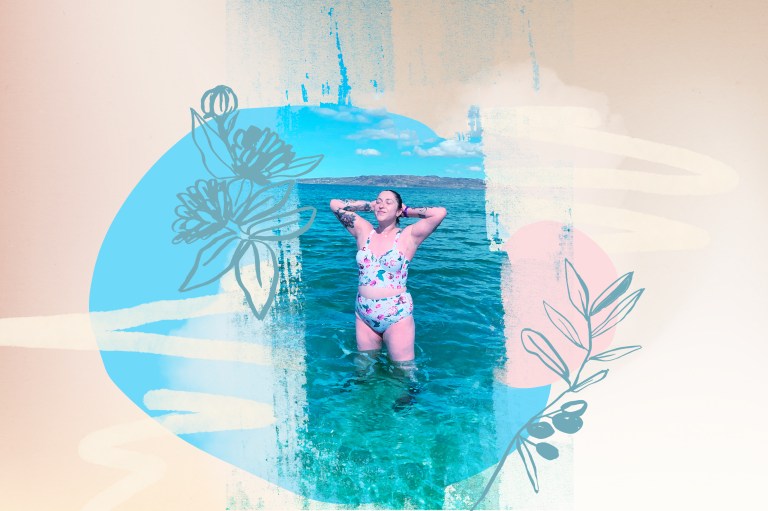How A Trip To The Grocery Store Changed My Perception Of Invisible Illness


“Are those the organic blueberries?”
I was staring intently at bags of frozen fruit in the grocery aisle when a friendly looking woman in a wheelchair approached me.
“Yes, they are. Would you like a package?”
“Yes please. My daughter has been bugging me for smoothies lately and the fresh berries are so expensive!”
I reached up to the top shelf to grab them and handed them to her.
“Yeah I hear ya. Plus they tend to go bad pretty quickly unless you use them up in a day or two. I’m trying to start eating healthier,” I gestured to my cart filled with my haphazard attempt at healthy groceries, a hodge-podge of whatever organic and GMO-free groceries happened to be on sale that week. “I’m trying everything I can to avoid neck surgery.” My oversized neck brace seemed to be the elephant in the room and felt the immediate need to explain. Instead she intercepted with a simple, “I understand.”
It is rare for anyone to approach me with my neck brace on. I must look like a pathetic excuse for a 28-year-old wearing practical shoes, my grandmother’s compression stockings and a neck brace. Not the epitome of young and hip that I used to be. I often feel self-conscious in the neck brace because I have suddenly become very aware that I and everyone else around me are aware of my disability. Until recently, I had tried my best to hide it in public.
I have a rare condition called craniocervical instability along with Type I Chiari malformation secondary to Ehlers-Danlos syndrome, a connective tissue disorder that makes my soft tissues too elastic. Simply put, my neck is a mess and the vertebrae keep sliding out of place because the glue of my body (connective tissues) can’t seem to hold it together. The brace is a temporary solution to help stabilize my neck. As for the Chiari malformation, a small piece of my cerebellum has fallen into my spinal column where it’s being compressed. My primary symptom is severe headaches at the base of my skull. Some days are better than others. Other days are torturous. But mostly, I look healthy on the outside. My brace is about the only thing that makes my disability apparent. It really cramps my personal style. But for now, it’s a necessity.
Like my neck brace, the woman’s wheelchair is also a necessity. But she certainly doesn’t let it define her. She exuded confidence in her own skin. Unlike most people, she did not ask me the typical question: “what happened?” or pry for the specific details of my ailment. She didn’t act like there was anything around my neck and did not treat me any differently because of it. Instead, she wished me luck and proceeded to share a succinct version of her own story with me. She was previously in perfect health until an arteriovenous malformation in her spinal cord spontaneously ruptured and rendered her paralyzed from the waist down. Since then, she has strived to make her health a priority for herself and her family.
Like me, she has experienced life from both ends of the spectrum: from able-bodied to disabled. I have become very frustrated with the limitations my body has imposed on me lately and can’t even begin to fathom how I would cope with being wheelchair bound. I am not as strong as she is. And this woman is a mother too. That in itself requires an incredible amount of strength, patience and fortitude. To parent with physical limitations must make motherhood that much more challenging. How on earth could I ever do it? I can hardly manage to take care of myself and my apartment on most days. Caring for another human being? I’m a long ways from being confident enough in my capabilities to tackle parenthood. How does she do it? This lady is clearly Superwoman…
That day at the grocery store I became hyper-aware of other people’s disabilities. I spotted two young women about my age, both using canes, the woman in the wheelchair and I in my neck brace. That makes four of us, all in the same rural grocery store at the same time. The canes, wheelchair and brace were the only obvious signs that each one of us had something seriously wrong with our health. Those devices rendered our otherwise invisible illnesses visible. I couldn’t help but wonder what was wrong with the other young women using the canes yet also wonder how many other people were browsing the grocery aisles that day without any apparent assistive devices who were suffering in silence from invisible disabilities, maybe even pretending to be perfectly fine…that is what I used to do, as I lacked the courage to openly come out with my disability.
The neck brace has made my once invisible disability visible. While the brace doesn’t make my life any easier, I think it does make it easier for others to relate to me on a personal level. I felt so comfortable talking to the woman in the wheelchair. She understood what I was going through without explanation. An unspoken, understood bond between people with disabilities. It was refreshing not to have to explain the complexities and daily struggle of my illness to her. Just to talk blueberries, smoothies and grocery prices like two regular women exchanging pleasantries.
“I hope you don’t have to have neck surgery,” she said as we parted ways. I hope so too, I thought.
“Thank you!” I said and really meant it. Our five-minute ordinary conversation meant the world to me. It was the first and only time a stranger has treated me like a normal person since I began wearing the brace. I emerged from the grocery store that day feeling a little less alone and a little more hopeful. Thank you. ![]()




